 Facebook
Facebook
 X
X
 Instagram
Instagram
 TikTok
TikTok
 Youtube
Youtube
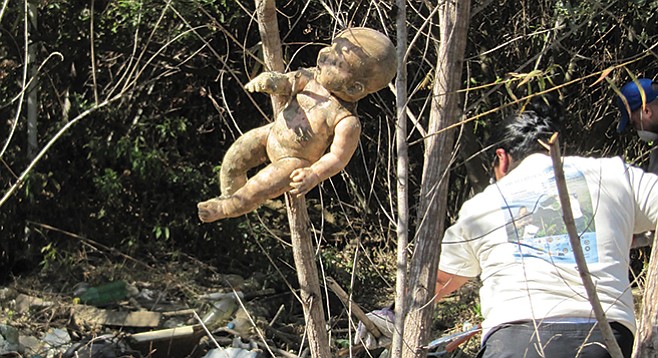
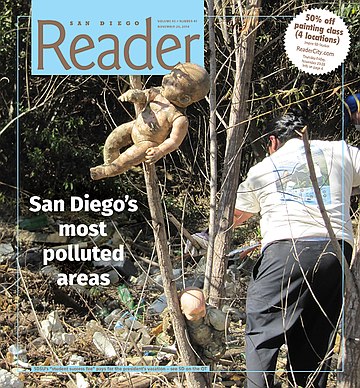
Beginning our tour of San Diego’s most befouled spots (air, land, or water), we stop first for three summer holidays — Memorial Day, July Fourth, Labor Day — when local beaches turn from sun havens into trash dumps. When party-hardy masses overrun Mission Beach, west of Belmont Park, they leave behind swaths of crap. There, at dawn, Cathy Ives, in her sandals and sun visor, surveys the carnage. She’s a citizen trash-trawler, she and her little red wagon, holiday or not, scour the beach for the non-biodegradable: styrofoam and booze bottles (though both are banned); plastic water bottles; torn Mylar balloons; boogie boards that crumble into foam beads, becoming bird or fish “food”; fast-food wrappers for sandwiches; cardboard boxes for pizza; and those little packets of hot sauce. (Predacious gulls pick through the piles or hungrily eye human junk-haulers.) Top finds in a year (from Ives’s website): bottle caps (20,000), broken toys (4000), whole toys (2142), 1/2 flip-flops (500), pairs of shoes (397), socks (343), plus T-shirts, cigarette butts (the nicotine and tar they release can be toxic to sea life) underwear, plastic bags, straws, cup lids, lighters, tennis balls, and Frisbees. Ives piles the goodies she can’t recycle behind her home, encouraging people to make trash projects of them, like flip-flop art.
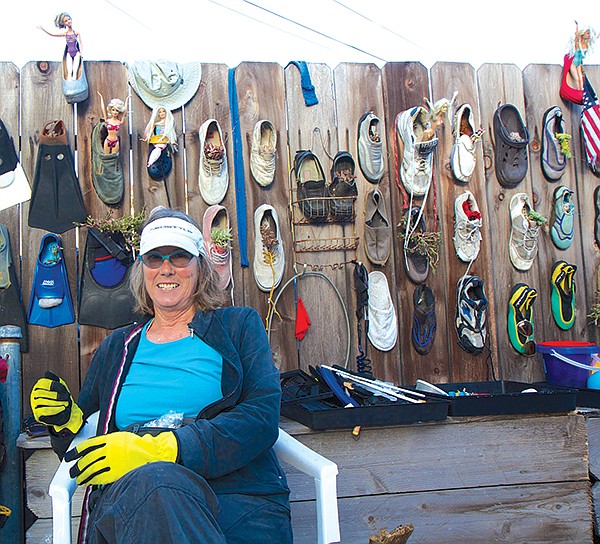
One peculiarity of the American need to trash is its treasure: there’s a market for picking up stuff, not only for Cathy Ives — she recycles or donates $10,000 to $20,000 worth of goods to the Encanto Boys and Girls Club each year — but also for the metal-detector sweepers who scan the sand for coins, jewelry, and cell phones.
Then there’re city workers, who arrive, post-holiday, at 4 a.m., bucketing, bagging, and front-loading in headlighted trucks hillocks of sandy trash for the dump. (July 5th, I arrived at 6 a.m., two hours late to get the full trash Monty. That weekend, city crews took out 1700 pounds of crap and 15,000 cigarette butts.) Workers earlier stationed refrigerator-size boxes to make recycling obvious. According to the Natural Resources Defense Council, San Diego spends $14.1 million per year to “stop litter from becoming pollution.”
Mission Beach is one of San Diego's most polluted areas. Cathy Ives discusses the origins and consequences of trash at the beach and shows off her remarkable collection.
You’d think beachgoers would want to take care of Southern California’s most precious natural resources — the ocean’s welcome mat — beach and breaking wave. But with scavengers, city workers, and pollution activists like Ives or volunteer groups like Surfrider, who regularly vacuum up our coastal waste, there’s little incentive to remove the garbage you bring in.
I don’t get it. Is there something about paradise or national holidays that requires tourists and locals to litter the beach? Don’t tourists value our usually pristine shores? Isn’t it common sense to think that others are coming after you? Don’t locals, especially in beach communities, want people to sun and surf for the sake of the economy? What part of this don’t we get?
The Escondido barrel yard opened in the 1940s, a stockpile of industrial waste oil and chlorinated solvents from Southern California businesses. On the five-acre site, workers stored leaky barrels and buried them as well as dumped liquids into ponds. They sprayed used motor oil over the site to keep the dust down. Over decades, the toxic waste dribbled into the groundwater.
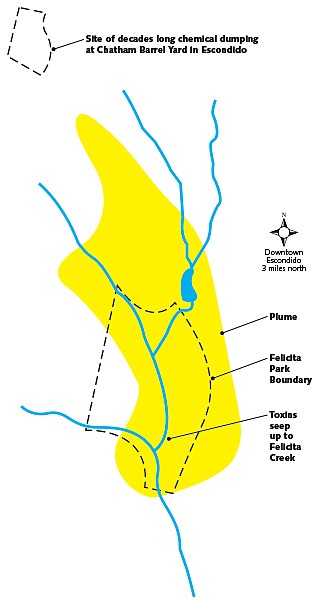
Though the operation ceased in 1981, the result has been a plume, in this case an underground, water-fueled cloud of toxic vapor and/or liquid that continues to spread. Fenced in 1984, the yard was designated a State Superfund Site in 1985; by 1990, 208 surface and 10 buried drums as well as 11,430 tons of soil had been removed; the cost, $30 million.
Today, the plume is a mile long, up to 1800 feet wide, and down 120 feet, though it is deeper in spots. It is migrating south, east, and west, largely under Felicita Park as well as seeping up into Felicita Creek, which ambles and pools through the park. In September, the San Diego Water Quality Control Board reported to the California Department of Toxic Substances Control that the discharge into the creek “is causing the direct exposure of human and ecological receptors to waste constituents that originate from the Site,” a violation of “discharge prohibitions.”
Doreen Reagle, a spokeswoman with Escondido Neighbors United who are fighting the plume, and two organic gardeners who live above it, take me on a walking tour of the park and a drive-by of the barrel yard. Reagle’s love of the area and its acre-minimum plots sparks her preservationist instinct: so many Escondidans moved in, she says, “because of the rural character, the animals, the mature trees, the twisty, tiny roads.”
The three produce a map of the underground blotch, ringed and measured by several private and state-run monitoring wells. These wells, at 50- and 100-foot depths, test for — and find — contaminated water.
Another potential problem is that a developer has proposed the 65-home Oak Creek housing cluster, which sits next door to the park on 42 acres of contaminated soil. Vegetable farmers have used pesticides on the site for decades. These chemicals are also prone to wash into the creek or the groundwater, fouling it further.
The main groundwater threats are the volatile organic compounds — dioxane, tetrachlorethylene, and polychlorinated biphenyls (PCBs) — that can “volatilize,” or percolate into homes as vapor. Exposure puts pregnant women and very young children at risk. Home testing is expensive and, advocates say, should be paid for by the 56 “Potentially Responsible Parties” who signed a consent decree in 1999 to clean up the plume. Twelve million gallons of contaminated groundwater at the yard site have been extracted or treated. The plume is still being treated, according to Toxic Substances Control.
Even before the scheduled five-year remedy review, Reagle and neighbors want signs posted warning parents and kids about unsafe creek water, homes sitting atop the plume tested, and an accelerated extraction — before the bad water spreads to Lake Hodges toward which they believe the plume is inexorably creeping. A spokesman for Toxic Substances Control says the plume “will never reach” the lake. The agency maintains the plume “does not appear to be advancing,” and that warnings are unnecessary, though all parties “are in the process of evaluating ways to inform park visitors” of any contamination.
Kinder Morgan, owner of the industrial tanks just north of Qualcomm Stadium, has spent $60 million since 1998 cleaning up the gasoline plume under the stadium. Escondido Neighbors would like the same effort on their buried mess.
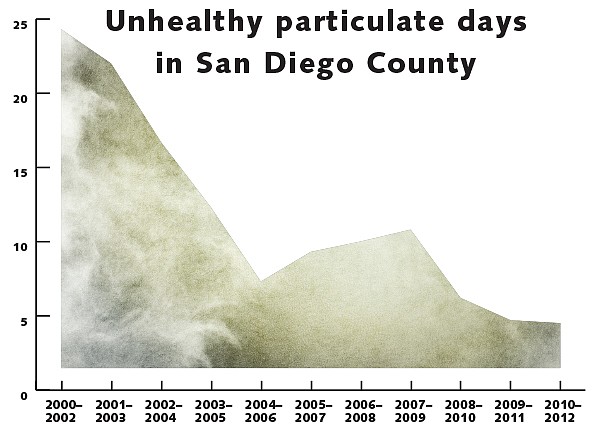
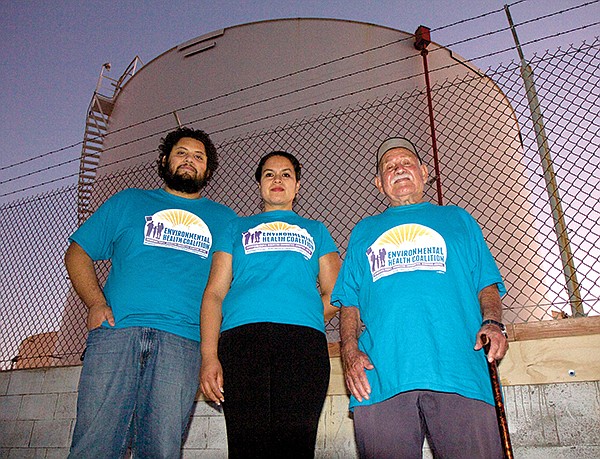
That’s what Barrio Logan has — a lot of them. It’s because of a concentrated haze of particulate matter, diesel fumes from trucks, cars, and ported ships a few blocks either side of East Harbor Drive. While better than a generation ago, the air still gets dirty on hot days and can be tough to breathe, especially for kids outdoors. So reports Joy Williams, Research Director of San Diego’s Environmental Health Coalition, which has been studying this over-industrialized site since the mid-1980s. The problem is, our noses can’t filter out the fine particles in air-born chemicals from solvents, metals, smoke, dust, and soot. Air saturated with such gunk may cause shortness of breath by reducing the capacity of the blood to carry oxygen.
Mega-spewers include General Dynamics-NASCCO, CP Kelco, the Burlington Northern Santa Fe railway, BP’s oil terminal, BAE Systems Ship Repair facility, the I-5 freeway, and legions of diesel trucks from Los Angeles and Mexico that hump cargo in and out. These cough-inducing, short-haul trucks and their engines have been cleaned up, legislatively, at least, by the state. They are checked for compliance before entering the Port’s cargo terminals. (Rivaling Barrio Logan’s poor air quality is that of the Otay Mesa crossing and the cities of El Cajon and Escondido where, as anyone living there will tell you, the breezeless valleys trap the air. At least Barrio Logan gets a gust from the ocean every now and again.)
In four of the last five years, the Barrio Logan air-quality monitoring station has failed to meet the EPA standard for particulate matter. It’s not easy to comply with these standards as the EPA keeps raising the bar. In part because the consequences can be deadly.
Barrio Logan is the second worst area in the county (the first is in and around Encanto) where people are hospitalized for respiratory illnesses, asthma, in particular. The California Office of Statewide Planning and Development shows that children in both communities visit emergency rooms with asthma-related conditions nearly three times the county average.
The core problem, Williams says, is the concentration of businesses in Barrio Logan’s narrow strip: the feds and the state can regulate a company’s emissions, but the state can’t say where the company locates its facilities. Thus, such industries often buckle-in next to each other, like Asian restaurants in a mini-mall, and the air surrounding East Harbor Drive can quickly be pickled with pollutants.
Williams says things are improving. One example: the coalition and the city banned diesel trucks on Cesar Chavez Parkway, through the heart of Barrio Logan. These days, trucks, achingly slow and noisy, must lumber south down Harbor Drive to 28th or 32nd streets to get on I-5.
Still, children whose lungs take in more air than the lungs of adults are most vulnerable. Persisting in poor neighborhoods through which heavy traffic rumbles is “near-road” pollution; some schools suffer because they were built before cars became so numerous. In a study of San Diego County’s traffic pollution, Paul English found that between 1993 and 1999 “those residing near high traffic flows (measured at the nearest street) were more likely than those residing near lower traffic flows to have two or more medical care visits for asthma than to have only one visit for asthma during the year.”
As everyone knows, the smoggiest days in San Diego come during Santa Ana–fueled fires. Remember the firenadoes of last May? In inland valley “hotspots,” the worst days are in the summer, when particulates mix with ozone, a gas beneficial to the earth’s atmosphere but hazardous to children and exercising adults when breathed. Human-made ozone, mostly from burning fossil fuels, is regulated by the Clean Air Act and the State of California.
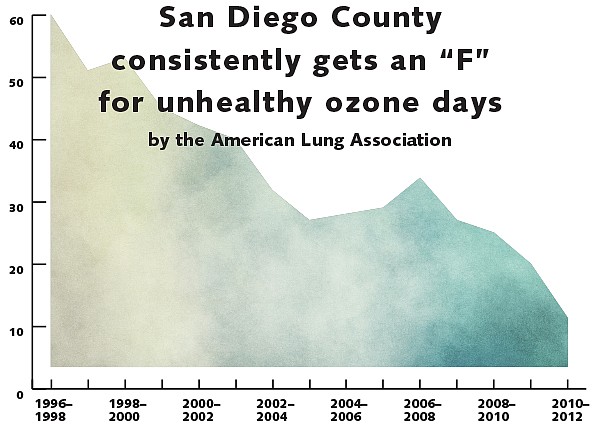
The American Lung Association consistently gives San Diego County an annual grade of “F” for ozone pollution. Though the number of yearly crappy air days has fallen from 60 to 11 in the past 15 years, people in Escondido, El Cajon, and Alpine get choked up easily in summer with some 34 “orange days,” defined as “unhealthful for sensitive groups.”
Bill Brick, senior meteorologist with the San Diego Air Pollution Control District, tells me that the dirtiest day of the year is January 1. Why? “People staying up late,” the night before, “their fireplaces going — and the fireworks.” Throw in night and morning low clouds, and on that day it’s unwise to run a 10K.
Brick, who grew up in Encinitas and thinks the air today is much improved from the coughing-and-retching days of his baseball youth, is all too familiar with San Diego’s “F.” The county is not in compliance with the current federal eight-hour ozone standard. That’s true, he notes. The EPA, he says, allows for a bad ozone day “once in a while,” he says, but “the American Lung Association doesn’t see it that way.” He believes San Diego (and his agency) doesn’t deserve an “F.” “We think we deserve an A for effort.”
Bonnie Holmes-Gen of the American Lung Association notes the “F” is based on federal standards and bad ozone days are “spread throughout the county.” I point out that our county’s average of unhealthful-for-the-sensitive days (34) is ten times better than Riverside County’s (234). Her reply: “We don’t grade on a curve.” Apparently, it’s a high “F.” Despite the grading flap, the California Air Resources Board estimates 580 premature air-pollution-related deaths occur every year in San Diego.
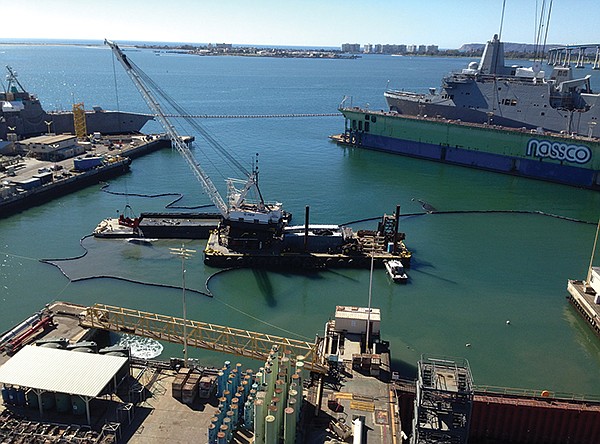
Our next stop on the San Diego pollution tour takes us to the bay just off Barrio Logan and the nearby bay-floor sediment. You wouldn’t know it by looking, but the bay, water and soil below, has been befouled for decades. Chief chemical offenders: copper (leaching out of boat-hull paints); mercury (mixing with bay-bottom bacteria as methylmercury); pesticides (diazinon and chlorphrifos, now banned but washed in via Chollas Creek); zinc, chlordane, and PCBs; trash, especially cigarette butts and plastic; and, the most toxic, pathogens (disease-harboring and human-sick-making microorganisms). The Water Quality Control Board has stipulated that the dredging include sand-fills, providing “coverage under existing piers and placement of a ridge or blanket of protective rock material adjacent to destabilized structures,” obviously those upset by the dredging process itself.
The two biggest polluters of the bay are National Steel and Shipbuilding Company and Southwest Marine, now BAE Systems. In 1999, the U.S. Supreme Court ordered BAE “to improve their storm water pollution prevention practices,” finding “the company liable for $799,000” in “permit violations.” Since then, the San Diego Bay Environmental Restoration Trust has been dredging sediment between September and March (to allow the California least tern to forage during the other months).
According to San Diego Bay Cleanup, the southern part of the project (next to National Steel) processed 1.1 million gallons of “decanted water” and removed 28,000 cubic yards, taken in 2000 truckloads to the Otay Mesa landfill. The next phase, underway this fall, will restore the north side, next to BAE: a much bigger operation, the dredge volume is estimated at 105,000 cubic yards. These two sites, while huge, are just two of 30 locations in San Diego Bay where either the water or the sediment is unhygienic.
Should you eat the fish that inhabit the bay?
Fish advisories abound. The Office of Environmental Health Hazard Assessment publishes its ironically titled “Healthy Guide” to eating fish from the bay. People should not eat the shiner perch and the topsmelt; and all, excepting pregnant women and children, should go easy on the croaker, the leopard shark, the basses, the mackerel, the stingray, the guitarfish, the lizardfish, and the turbot. (Mission Bay is slightly less restrictive: check out the website.) The threat is real: there’s a chance of brain damage for unborn babies and cancer for the rest of us.
The amount of toxic waste dumped and groundwater and soil polluted from 1942 to today and the costs to assess, remove, and treat the mess at the 125,000-acre Marine base are staggering. Costs first: in 2005, $250 million, from the Environmental Protection Agency, to scope the problem; today, another $278 million, from the Pentagon, via the Department of the Navy, to initiate the decades’ long cleanup.
The number of toxic calamities on the base, first described in a 2004 agency report, was 208. In addition, 250 underground fuel tanks were leaking. The current site-count is 74, of which 58 “have been cleaned up and/or closed,” a Pendleton spokesman says. Sixteen sites are “in different phases” of cleanup.
In 1980, the multi-billion-dollar Superfund was passed by Congress to clean up toxic sites that threaten (or have damaged) public health. Pendleton’s problems are detailed on the Environmental Protection Agency website: groundwater and soils “contaminated with volatile organic compounds, spent oils, fuels, PCBs, pesticides, metals, and herbicides.” Tainted water remains in landfills, “surface impoundments,” and the Santa Margarita River, which runs into the Pacific Ocean and which many Marines and their families have drunk for years.
The surface soils seem hardest hit. Crews have trucked out 14,000 cubic yards of dirt, which contain trichloroethane and petroleum hydrocarbons. Another 37,000 yards came out, packed with pesticides such as DDT. The earth was dumped off-site, in Arizona and Nevada.
Over the years, officials have compiled a litany of pollution events: the pipes that once carried drinking water had dangerously high levels of lead and copper (these pipes have been repaired, Pendleton says); the liner for a base landfill broke and leaked radioactive runoff, called leachate; large bladders, housing 300,000 gallons of leachate, are contaminated with tritium, a radioactive chemical; one lawsuit claimed a young girl on the base suffered “mental impairment” from breathing thallium, a toxic metal used in rat poison; and plumes of chlorinated solvents keep migrating, like those from Chatham barrel yard, to wells on-site and community-close. One of these wells abuts Oceanside; from it, 650,000 gallons of groundwater have been siphoned. “More work,” a Navy report says, “needs to be done.”
Site #22/23 is a major industrial dump, its groundwater intermingling with the Santa Margarita River. Under its 425 acres are five plumes of dirtied groundwater, shallow at 7–14 feet. A classic of Naval bureaucratese, the cleanup mandate states: “Long-term monitoring and land use controls that limit exposure to contaminated groundwater by setting limits on activities, use, or access, will make sure that this solution is effective.” This single $18.2 million restoration project will take 30 years.
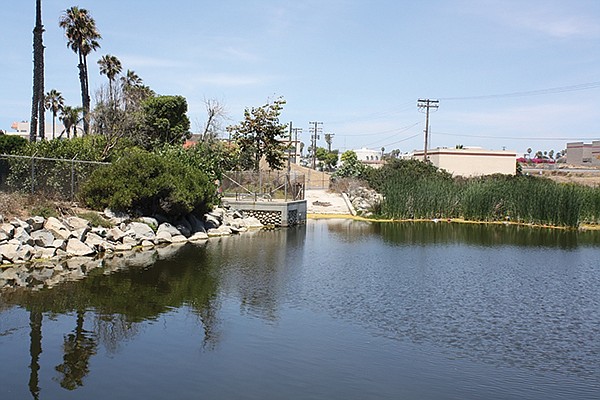
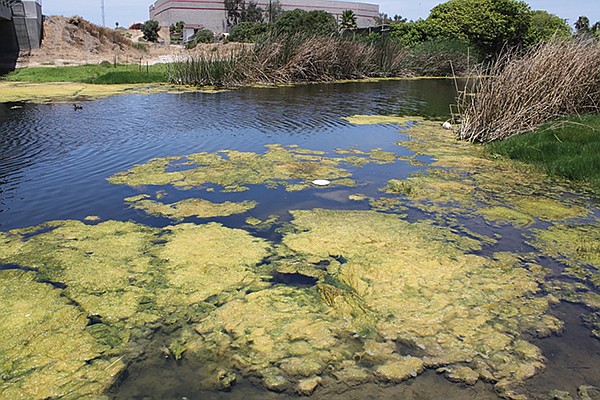
The algae covering much of the Loma Alta Slough in Oceanside looks like a mat of green slime, a soiled, floating cotton quilt. As the creek works its seven-mile run, much via a concrete-lined channel, from Vista to the sea, the bloom, efflorescing in summer, is caused by urban stream syndrome, also known as “urban drool.” This polluted runoff includes pet waste, fertilizer nitrates, soaps, pesticides, motor oil, brake-pad dust, and effluent from the occasional cracked sewer line.
Engineering geologist Barry Pulver, with the Water Quality Control Board, explains two problems associated with the slough. We’re walking beside the creek, where egrets catch and gobble the swarming gambusia, or mosquito fish, while ducks mosey by oblivious. The first public health problem is fecal bacteria, E. coli, which often cause beach, bay, or creek closures. Beside Buccaneer Park, we spot “No Swimming” signs and this, “Caution: Storm drain water may pose an increased risk of illness. Avoid contact near outlet.” It’s a hot day, and families sunbathe nearby.
The very young and the elderly who contract E. coli are bedeviled by diarrhea and dehydration. Infections may worsen with blood disorders, kidney failure, and severely compromised immune systems.
Second, an environmental problem, is eutrophic pollution. Because the slough’s flow does not reach the sea, except briefly in winter, the algae, with heat and sunlight, stagnates and accrues heavy concentrations. The result: the water’s oxygen is severely reduced. Fish and mollusks as well as underwater plants, the benthic community, die. As the algae withers in cooler weather, it sinks and wreaks more damage on the bed below. The slough then sports a rusty tint, made by phytoplankton, also known as red tide. In August, Toledo, Ohio, was hit with a monster algae bloom that contaminated the drinking water for days.
I ask Mo Lahsaie, Oceanside’s environmental officer, why Loma Alta and the sea aren’t kept connected. He says that once, before 1940, there was a natural estuary there. Over time, the creek channel has been squeezed by housing, boulevards, and malls, and by sandbars brought on from winter storms. In the rainy season, the channel may flood and break an opening to the sea. “But even if the city dredged” a culvert or a floodgate, Lahsaie says, the ocean-deposited sands of winter “will just close it up again.”
The worst bloom is the blue-green algae, a cyanobacteria outbreak that can be deadly to animals and humans. Pulver’s seen it here before; “that can be bad,” he says. And yet, overall, he’s sanguine about the region’s cleanup campaign, developing much stakeholder and citizen awareness, which, via education, reminds people to stop polluting the neighborhood. Be careful: a plan’s afoot to have city meter-readers report you if your irrigation water runs off into the street. Cease and desist — and pay the fine.
It’s called “dirty electricity” or EMF (electromagnetic field) pollution. A subset is ELF, or extremely low frequency. The sources of these flesh-piercing waves include appliances, power lines, and building wiring, at work and at home: transmission (the Cyclopean towers bounding through the backcountry) and distribution lines (telephone poles) disseminate magnetic fields. Your hair dryer and your microwave oven (from which it’s wise to stand back) emit concentrated electrical pollution.
The evidence that it harms us is uncertain or, better, understudied. And yet I read this in an email from Dr. Samuel Milham, physician-epidemiologist and author of Dirty Electricity: “Every high rise in San Diego and in every major city in the world has high levels of electrical pollution. I measured the 11th floor offices of Thorsnes, Bartolotta and McGuire at 2250 5th Avenue, 11th floor. Most offices have computers, wireless routers, copy machines and compact fluorescent lights, all of which generate electrical pollution. In addition, the upper floors have pollution from the microwave towers on the roof. I was there in a futile attempt to get the firm to take a school cancer cluster case. The readings I made were not requested. However, every office building I’ve measured has the same problem. As a consequence, office workers and secretaries have high cancer rates. Schools have the same problem, and teachers have high mortality rates.”
Ouch! Really? Every high-rise in San Diego? Do electromagnetic concentrations become “cancer clusters”? How worried should we be? Thorsnes, Bartolotta did not respond to my query.
California ended its electromagnetic field program in the mid-2000s. The state maintains a website with a fact sheet and a “risk evaluation report,” concluding that with electromagnetic fields there’s “some degree of risk of childhood leukemia, adult brain cancer, Lou Gehrig’s disease, and miscarriage.” Experts in the agency parted company, citing a dividing line between those “believing” and those “not believing.”
It seems San Diego Gas & Electric is taking this seriously. Prompted by warnings from the World Health Organization, the utility acknowledges health “questions” surrounding electromagnetic transmissions, “found everywhere you have electric power.” Their advice? Move electric devices away from the head of the bed; limit time with hair dryers, electric razors, heating pads, and electric blankets. And this: “If you feel reducing your EMF exposure would be beneficial, you can increase your distance” from its sources.
The other worrisome polluter is the cell phone.
The World Health Organization classifies radio-frequency fields produced by phones “as possibly carcinogenic to humans.” Cheery news. They also say that “to date, no adverse health effects have been established” from mobile phones. Cheerier but not a consensus, in part, because cancers from electromagnetic transmission are slow growing. A generation of users is needed to evince a link. But isn’t that what was said about tobacco and lung cancer? We weren’t sure — and then we were, after hundreds of thousands started dying of the disease.
The odd thing about the Tijuana Estuary is that most people think it’s our border with Mexico. It’s not. Immediately north of Border Field State Park, the Tijuana Slough National Wildlife Refuge, the National Estuarine, and the County Open Space Preserve are on American soil. The estuary is southwest of Interstate 5, so it’s rarely seen by those who drive across the border every day. The pollution problem is hidden in the riparian thickets, which in summer smell of pesticides, horse stables, and moving dust, while in winter the whole thing’s a churning heap of sewage and debris — one watcher says trash flows can be as high as 15 feet — lumbering its way down some 28 canyons, including Goat Canyon and Smuggler’s Gulch, from the city of 1.7 million.
How bad can it get?
One of the highest measurements for bacteria in contaminated sewage runoff (a sloshy murk of human and animal waste) at the mouth of the Tijuana Estuary ever recorded occurred on May 7, 2013: a total coliform of 3 million, 300 hundred times the “safe” standard (10,000 organisms per 100 milliliter), and fecal coliforms of 800,000, or 2000 times the “safe” standard (400 organisms per 100 milliliter). Such spikes of coliform mean that pathogenic bacteria and viruses — microorganisms that make people sick with gastroenteritis, typhoid fever, dysentery, diarrhea, infectious hepatitis, and cholera—are present. That May 7th spill got beach closure signs up in a flash. Coastal and bay warnings, advisories, and closures have lasted between three and sixteen days.
The good news in the summer is that a recently built wastewater-treatment plant, to which the river has been diverted, handles 30 million gallons of sewage a day.
Winter downpours bring the maximum stress. Plants are choked by the hundreds of millions of gallons of Tijuana rainwater-cum-effluent; spills embrown the slough and the ocean, closing beaches from the border to Imperial Beach. In 2013, the Tijuana River at mouth and border was closed for rain advisories, bacterial and other precautions, some 204 days. It was restricted 7 more days for sanitary sewer overflows.
Surfers can see the chocolaty water in winter and smell the shit. Many get hepatitis A vaccines, though this doesn’t stop the skin rashes, digestive disorders, and ear and eye infections.
Top honors for the most worrisome pollution goes to the King of Trash: ocean debris.
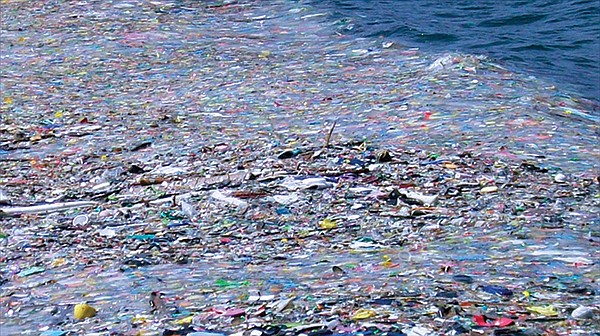
According to I Love a Clean San Diego, 80 percent of the crap floating and sinking in the Pacific “comes from land-based sources.” This means that, before it gets to the ocean, four of five trash piles travel through San Diego’s (or any other coastal city’s) vast watershed system. The ocean pulls the junk far out to sea, where the plastic bits and pieces swirl into eddies. The Garbage Patch in the northern Pacific is the planet’s worst.
One estimate puts this gyre at 5.8 million square miles, twice the size of the land mass of the United States. (It should be noted there’s little agreement as to its actual size because of its dynamic nature.) The vilest pollutants: glass bottles (decomposition rate: undetermined), fishing line (600 years), disposable diapers (450 years), and plastic bottles (450 years).
Every hour, one study notes, 100,000 plastic bottles wash into the world’s oceans. As most anti-pollution websites remind us, every piece of plastic ever produced anywhere on the globe still exists.
I should stop before this gets more awful than it already is.
Thanks to the Environmental Health Coalition, inaccuracies in "Bad Air Days," about air quality, polluters, and the percentage of asthma cases in Barrio Logan, have been corrected.



Beginning our tour of San Diego’s most befouled spots (air, land, or water), we stop first for three summer holidays — Memorial Day, July Fourth, Labor Day — when local beaches turn from sun havens into trash dumps. When party-hardy masses overrun Mission Beach, west of Belmont Park, they leave behind swaths of crap. There, at dawn, Cathy Ives, in her sandals and sun visor, surveys the carnage. She’s a citizen trash-trawler, she and her little red wagon, holiday or not, scour the beach for the non-biodegradable: styrofoam and booze bottles (though both are banned); plastic water bottles; torn Mylar balloons; boogie boards that crumble into foam beads, becoming bird or fish “food”; fast-food wrappers for sandwiches; cardboard boxes for pizza; and those little packets of hot sauce. (Predacious gulls pick through the piles or hungrily eye human junk-haulers.) Top finds in a year (from Ives’s website): bottle caps (20,000), broken toys (4000), whole toys (2142), 1/2 flip-flops (500), pairs of shoes (397), socks (343), plus T-shirts, cigarette butts (the nicotine and tar they release can be toxic to sea life) underwear, plastic bags, straws, cup lids, lighters, tennis balls, and Frisbees. Ives piles the goodies she can’t recycle behind her home, encouraging people to make trash projects of them, like flip-flop art.

One peculiarity of the American need to trash is its treasure: there’s a market for picking up stuff, not only for Cathy Ives — she recycles or donates $10,000 to $20,000 worth of goods to the Encanto Boys and Girls Club each year — but also for the metal-detector sweepers who scan the sand for coins, jewelry, and cell phones.
Then there’re city workers, who arrive, post-holiday, at 4 a.m., bucketing, bagging, and front-loading in headlighted trucks hillocks of sandy trash for the dump. (July 5th, I arrived at 6 a.m., two hours late to get the full trash Monty. That weekend, city crews took out 1700 pounds of crap and 15,000 cigarette butts.) Workers earlier stationed refrigerator-size boxes to make recycling obvious. According to the Natural Resources Defense Council, San Diego spends $14.1 million per year to “stop litter from becoming pollution.”
Mission Beach is one of San Diego's most polluted areas. Cathy Ives discusses the origins and consequences of trash at the beach and shows off her remarkable collection.
You’d think beachgoers would want to take care of Southern California’s most precious natural resources — the ocean’s welcome mat — beach and breaking wave. But with scavengers, city workers, and pollution activists like Ives or volunteer groups like Surfrider, who regularly vacuum up our coastal waste, there’s little incentive to remove the garbage you bring in.
I don’t get it. Is there something about paradise or national holidays that requires tourists and locals to litter the beach? Don’t tourists value our usually pristine shores? Isn’t it common sense to think that others are coming after you? Don’t locals, especially in beach communities, want people to sun and surf for the sake of the economy? What part of this don’t we get?
The Escondido barrel yard opened in the 1940s, a stockpile of industrial waste oil and chlorinated solvents from Southern California businesses. On the five-acre site, workers stored leaky barrels and buried them as well as dumped liquids into ponds. They sprayed used motor oil over the site to keep the dust down. Over decades, the toxic waste dribbled into the groundwater.

Though the operation ceased in 1981, the result has been a plume, in this case an underground, water-fueled cloud of toxic vapor and/or liquid that continues to spread. Fenced in 1984, the yard was designated a State Superfund Site in 1985; by 1990, 208 surface and 10 buried drums as well as 11,430 tons of soil had been removed; the cost, $30 million.
Today, the plume is a mile long, up to 1800 feet wide, and down 120 feet, though it is deeper in spots. It is migrating south, east, and west, largely under Felicita Park as well as seeping up into Felicita Creek, which ambles and pools through the park. In September, the San Diego Water Quality Control Board reported to the California Department of Toxic Substances Control that the discharge into the creek “is causing the direct exposure of human and ecological receptors to waste constituents that originate from the Site,” a violation of “discharge prohibitions.”
Doreen Reagle, a spokeswoman with Escondido Neighbors United who are fighting the plume, and two organic gardeners who live above it, take me on a walking tour of the park and a drive-by of the barrel yard. Reagle’s love of the area and its acre-minimum plots sparks her preservationist instinct: so many Escondidans moved in, she says, “because of the rural character, the animals, the mature trees, the twisty, tiny roads.”
The three produce a map of the underground blotch, ringed and measured by several private and state-run monitoring wells. These wells, at 50- and 100-foot depths, test for — and find — contaminated water.
Another potential problem is that a developer has proposed the 65-home Oak Creek housing cluster, which sits next door to the park on 42 acres of contaminated soil. Vegetable farmers have used pesticides on the site for decades. These chemicals are also prone to wash into the creek or the groundwater, fouling it further.
The main groundwater threats are the volatile organic compounds — dioxane, tetrachlorethylene, and polychlorinated biphenyls (PCBs) — that can “volatilize,” or percolate into homes as vapor. Exposure puts pregnant women and very young children at risk. Home testing is expensive and, advocates say, should be paid for by the 56 “Potentially Responsible Parties” who signed a consent decree in 1999 to clean up the plume. Twelve million gallons of contaminated groundwater at the yard site have been extracted or treated. The plume is still being treated, according to Toxic Substances Control.
Even before the scheduled five-year remedy review, Reagle and neighbors want signs posted warning parents and kids about unsafe creek water, homes sitting atop the plume tested, and an accelerated extraction — before the bad water spreads to Lake Hodges toward which they believe the plume is inexorably creeping. A spokesman for Toxic Substances Control says the plume “will never reach” the lake. The agency maintains the plume “does not appear to be advancing,” and that warnings are unnecessary, though all parties “are in the process of evaluating ways to inform park visitors” of any contamination.
Kinder Morgan, owner of the industrial tanks just north of Qualcomm Stadium, has spent $60 million since 1998 cleaning up the gasoline plume under the stadium. Escondido Neighbors would like the same effort on their buried mess.


That’s what Barrio Logan has — a lot of them. It’s because of a concentrated haze of particulate matter, diesel fumes from trucks, cars, and ported ships a few blocks either side of East Harbor Drive. While better than a generation ago, the air still gets dirty on hot days and can be tough to breathe, especially for kids outdoors. So reports Joy Williams, Research Director of San Diego’s Environmental Health Coalition, which has been studying this over-industrialized site since the mid-1980s. The problem is, our noses can’t filter out the fine particles in air-born chemicals from solvents, metals, smoke, dust, and soot. Air saturated with such gunk may cause shortness of breath by reducing the capacity of the blood to carry oxygen.
Mega-spewers include General Dynamics-NASCCO, CP Kelco, the Burlington Northern Santa Fe railway, BP’s oil terminal, BAE Systems Ship Repair facility, the I-5 freeway, and legions of diesel trucks from Los Angeles and Mexico that hump cargo in and out. These cough-inducing, short-haul trucks and their engines have been cleaned up, legislatively, at least, by the state. They are checked for compliance before entering the Port’s cargo terminals. (Rivaling Barrio Logan’s poor air quality is that of the Otay Mesa crossing and the cities of El Cajon and Escondido where, as anyone living there will tell you, the breezeless valleys trap the air. At least Barrio Logan gets a gust from the ocean every now and again.)
In four of the last five years, the Barrio Logan air-quality monitoring station has failed to meet the EPA standard for particulate matter. It’s not easy to comply with these standards as the EPA keeps raising the bar. In part because the consequences can be deadly.
Barrio Logan is the second worst area in the county (the first is in and around Encanto) where people are hospitalized for respiratory illnesses, asthma, in particular. The California Office of Statewide Planning and Development shows that children in both communities visit emergency rooms with asthma-related conditions nearly three times the county average.
The core problem, Williams says, is the concentration of businesses in Barrio Logan’s narrow strip: the feds and the state can regulate a company’s emissions, but the state can’t say where the company locates its facilities. Thus, such industries often buckle-in next to each other, like Asian restaurants in a mini-mall, and the air surrounding East Harbor Drive can quickly be pickled with pollutants.
Williams says things are improving. One example: the coalition and the city banned diesel trucks on Cesar Chavez Parkway, through the heart of Barrio Logan. These days, trucks, achingly slow and noisy, must lumber south down Harbor Drive to 28th or 32nd streets to get on I-5.
Still, children whose lungs take in more air than the lungs of adults are most vulnerable. Persisting in poor neighborhoods through which heavy traffic rumbles is “near-road” pollution; some schools suffer because they were built before cars became so numerous. In a study of San Diego County’s traffic pollution, Paul English found that between 1993 and 1999 “those residing near high traffic flows (measured at the nearest street) were more likely than those residing near lower traffic flows to have two or more medical care visits for asthma than to have only one visit for asthma during the year.”
As everyone knows, the smoggiest days in San Diego come during Santa Ana–fueled fires. Remember the firenadoes of last May? In inland valley “hotspots,” the worst days are in the summer, when particulates mix with ozone, a gas beneficial to the earth’s atmosphere but hazardous to children and exercising adults when breathed. Human-made ozone, mostly from burning fossil fuels, is regulated by the Clean Air Act and the State of California.

The American Lung Association consistently gives San Diego County an annual grade of “F” for ozone pollution. Though the number of yearly crappy air days has fallen from 60 to 11 in the past 15 years, people in Escondido, El Cajon, and Alpine get choked up easily in summer with some 34 “orange days,” defined as “unhealthful for sensitive groups.”
Bill Brick, senior meteorologist with the San Diego Air Pollution Control District, tells me that the dirtiest day of the year is January 1. Why? “People staying up late,” the night before, “their fireplaces going — and the fireworks.” Throw in night and morning low clouds, and on that day it’s unwise to run a 10K.
Brick, who grew up in Encinitas and thinks the air today is much improved from the coughing-and-retching days of his baseball youth, is all too familiar with San Diego’s “F.” The county is not in compliance with the current federal eight-hour ozone standard. That’s true, he notes. The EPA, he says, allows for a bad ozone day “once in a while,” he says, but “the American Lung Association doesn’t see it that way.” He believes San Diego (and his agency) doesn’t deserve an “F.” “We think we deserve an A for effort.”
Bonnie Holmes-Gen of the American Lung Association notes the “F” is based on federal standards and bad ozone days are “spread throughout the county.” I point out that our county’s average of unhealthful-for-the-sensitive days (34) is ten times better than Riverside County’s (234). Her reply: “We don’t grade on a curve.” Apparently, it’s a high “F.” Despite the grading flap, the California Air Resources Board estimates 580 premature air-pollution-related deaths occur every year in San Diego.

Our next stop on the San Diego pollution tour takes us to the bay just off Barrio Logan and the nearby bay-floor sediment. You wouldn’t know it by looking, but the bay, water and soil below, has been befouled for decades. Chief chemical offenders: copper (leaching out of boat-hull paints); mercury (mixing with bay-bottom bacteria as methylmercury); pesticides (diazinon and chlorphrifos, now banned but washed in via Chollas Creek); zinc, chlordane, and PCBs; trash, especially cigarette butts and plastic; and, the most toxic, pathogens (disease-harboring and human-sick-making microorganisms). The Water Quality Control Board has stipulated that the dredging include sand-fills, providing “coverage under existing piers and placement of a ridge or blanket of protective rock material adjacent to destabilized structures,” obviously those upset by the dredging process itself.
The two biggest polluters of the bay are National Steel and Shipbuilding Company and Southwest Marine, now BAE Systems. In 1999, the U.S. Supreme Court ordered BAE “to improve their storm water pollution prevention practices,” finding “the company liable for $799,000” in “permit violations.” Since then, the San Diego Bay Environmental Restoration Trust has been dredging sediment between September and March (to allow the California least tern to forage during the other months).
According to San Diego Bay Cleanup, the southern part of the project (next to National Steel) processed 1.1 million gallons of “decanted water” and removed 28,000 cubic yards, taken in 2000 truckloads to the Otay Mesa landfill. The next phase, underway this fall, will restore the north side, next to BAE: a much bigger operation, the dredge volume is estimated at 105,000 cubic yards. These two sites, while huge, are just two of 30 locations in San Diego Bay where either the water or the sediment is unhygienic.
Should you eat the fish that inhabit the bay?
Fish advisories abound. The Office of Environmental Health Hazard Assessment publishes its ironically titled “Healthy Guide” to eating fish from the bay. People should not eat the shiner perch and the topsmelt; and all, excepting pregnant women and children, should go easy on the croaker, the leopard shark, the basses, the mackerel, the stingray, the guitarfish, the lizardfish, and the turbot. (Mission Bay is slightly less restrictive: check out the website.) The threat is real: there’s a chance of brain damage for unborn babies and cancer for the rest of us.
The amount of toxic waste dumped and groundwater and soil polluted from 1942 to today and the costs to assess, remove, and treat the mess at the 125,000-acre Marine base are staggering. Costs first: in 2005, $250 million, from the Environmental Protection Agency, to scope the problem; today, another $278 million, from the Pentagon, via the Department of the Navy, to initiate the decades’ long cleanup.
The number of toxic calamities on the base, first described in a 2004 agency report, was 208. In addition, 250 underground fuel tanks were leaking. The current site-count is 74, of which 58 “have been cleaned up and/or closed,” a Pendleton spokesman says. Sixteen sites are “in different phases” of cleanup.
In 1980, the multi-billion-dollar Superfund was passed by Congress to clean up toxic sites that threaten (or have damaged) public health. Pendleton’s problems are detailed on the Environmental Protection Agency website: groundwater and soils “contaminated with volatile organic compounds, spent oils, fuels, PCBs, pesticides, metals, and herbicides.” Tainted water remains in landfills, “surface impoundments,” and the Santa Margarita River, which runs into the Pacific Ocean and which many Marines and their families have drunk for years.
The surface soils seem hardest hit. Crews have trucked out 14,000 cubic yards of dirt, which contain trichloroethane and petroleum hydrocarbons. Another 37,000 yards came out, packed with pesticides such as DDT. The earth was dumped off-site, in Arizona and Nevada.
Over the years, officials have compiled a litany of pollution events: the pipes that once carried drinking water had dangerously high levels of lead and copper (these pipes have been repaired, Pendleton says); the liner for a base landfill broke and leaked radioactive runoff, called leachate; large bladders, housing 300,000 gallons of leachate, are contaminated with tritium, a radioactive chemical; one lawsuit claimed a young girl on the base suffered “mental impairment” from breathing thallium, a toxic metal used in rat poison; and plumes of chlorinated solvents keep migrating, like those from Chatham barrel yard, to wells on-site and community-close. One of these wells abuts Oceanside; from it, 650,000 gallons of groundwater have been siphoned. “More work,” a Navy report says, “needs to be done.”
Site #22/23 is a major industrial dump, its groundwater intermingling with the Santa Margarita River. Under its 425 acres are five plumes of dirtied groundwater, shallow at 7–14 feet. A classic of Naval bureaucratese, the cleanup mandate states: “Long-term monitoring and land use controls that limit exposure to contaminated groundwater by setting limits on activities, use, or access, will make sure that this solution is effective.” This single $18.2 million restoration project will take 30 years.


The algae covering much of the Loma Alta Slough in Oceanside looks like a mat of green slime, a soiled, floating cotton quilt. As the creek works its seven-mile run, much via a concrete-lined channel, from Vista to the sea, the bloom, efflorescing in summer, is caused by urban stream syndrome, also known as “urban drool.” This polluted runoff includes pet waste, fertilizer nitrates, soaps, pesticides, motor oil, brake-pad dust, and effluent from the occasional cracked sewer line.
Engineering geologist Barry Pulver, with the Water Quality Control Board, explains two problems associated with the slough. We’re walking beside the creek, where egrets catch and gobble the swarming gambusia, or mosquito fish, while ducks mosey by oblivious. The first public health problem is fecal bacteria, E. coli, which often cause beach, bay, or creek closures. Beside Buccaneer Park, we spot “No Swimming” signs and this, “Caution: Storm drain water may pose an increased risk of illness. Avoid contact near outlet.” It’s a hot day, and families sunbathe nearby.
The very young and the elderly who contract E. coli are bedeviled by diarrhea and dehydration. Infections may worsen with blood disorders, kidney failure, and severely compromised immune systems.
Second, an environmental problem, is eutrophic pollution. Because the slough’s flow does not reach the sea, except briefly in winter, the algae, with heat and sunlight, stagnates and accrues heavy concentrations. The result: the water’s oxygen is severely reduced. Fish and mollusks as well as underwater plants, the benthic community, die. As the algae withers in cooler weather, it sinks and wreaks more damage on the bed below. The slough then sports a rusty tint, made by phytoplankton, also known as red tide. In August, Toledo, Ohio, was hit with a monster algae bloom that contaminated the drinking water for days.
I ask Mo Lahsaie, Oceanside’s environmental officer, why Loma Alta and the sea aren’t kept connected. He says that once, before 1940, there was a natural estuary there. Over time, the creek channel has been squeezed by housing, boulevards, and malls, and by sandbars brought on from winter storms. In the rainy season, the channel may flood and break an opening to the sea. “But even if the city dredged” a culvert or a floodgate, Lahsaie says, the ocean-deposited sands of winter “will just close it up again.”
The worst bloom is the blue-green algae, a cyanobacteria outbreak that can be deadly to animals and humans. Pulver’s seen it here before; “that can be bad,” he says. And yet, overall, he’s sanguine about the region’s cleanup campaign, developing much stakeholder and citizen awareness, which, via education, reminds people to stop polluting the neighborhood. Be careful: a plan’s afoot to have city meter-readers report you if your irrigation water runs off into the street. Cease and desist — and pay the fine.
It’s called “dirty electricity” or EMF (electromagnetic field) pollution. A subset is ELF, or extremely low frequency. The sources of these flesh-piercing waves include appliances, power lines, and building wiring, at work and at home: transmission (the Cyclopean towers bounding through the backcountry) and distribution lines (telephone poles) disseminate magnetic fields. Your hair dryer and your microwave oven (from which it’s wise to stand back) emit concentrated electrical pollution.
The evidence that it harms us is uncertain or, better, understudied. And yet I read this in an email from Dr. Samuel Milham, physician-epidemiologist and author of Dirty Electricity: “Every high rise in San Diego and in every major city in the world has high levels of electrical pollution. I measured the 11th floor offices of Thorsnes, Bartolotta and McGuire at 2250 5th Avenue, 11th floor. Most offices have computers, wireless routers, copy machines and compact fluorescent lights, all of which generate electrical pollution. In addition, the upper floors have pollution from the microwave towers on the roof. I was there in a futile attempt to get the firm to take a school cancer cluster case. The readings I made were not requested. However, every office building I’ve measured has the same problem. As a consequence, office workers and secretaries have high cancer rates. Schools have the same problem, and teachers have high mortality rates.”
Ouch! Really? Every high-rise in San Diego? Do electromagnetic concentrations become “cancer clusters”? How worried should we be? Thorsnes, Bartolotta did not respond to my query.
California ended its electromagnetic field program in the mid-2000s. The state maintains a website with a fact sheet and a “risk evaluation report,” concluding that with electromagnetic fields there’s “some degree of risk of childhood leukemia, adult brain cancer, Lou Gehrig’s disease, and miscarriage.” Experts in the agency parted company, citing a dividing line between those “believing” and those “not believing.”
It seems San Diego Gas & Electric is taking this seriously. Prompted by warnings from the World Health Organization, the utility acknowledges health “questions” surrounding electromagnetic transmissions, “found everywhere you have electric power.” Their advice? Move electric devices away from the head of the bed; limit time with hair dryers, electric razors, heating pads, and electric blankets. And this: “If you feel reducing your EMF exposure would be beneficial, you can increase your distance” from its sources.
The other worrisome polluter is the cell phone.
The World Health Organization classifies radio-frequency fields produced by phones “as possibly carcinogenic to humans.” Cheery news. They also say that “to date, no adverse health effects have been established” from mobile phones. Cheerier but not a consensus, in part, because cancers from electromagnetic transmission are slow growing. A generation of users is needed to evince a link. But isn’t that what was said about tobacco and lung cancer? We weren’t sure — and then we were, after hundreds of thousands started dying of the disease.
The odd thing about the Tijuana Estuary is that most people think it’s our border with Mexico. It’s not. Immediately north of Border Field State Park, the Tijuana Slough National Wildlife Refuge, the National Estuarine, and the County Open Space Preserve are on American soil. The estuary is southwest of Interstate 5, so it’s rarely seen by those who drive across the border every day. The pollution problem is hidden in the riparian thickets, which in summer smell of pesticides, horse stables, and moving dust, while in winter the whole thing’s a churning heap of sewage and debris — one watcher says trash flows can be as high as 15 feet — lumbering its way down some 28 canyons, including Goat Canyon and Smuggler’s Gulch, from the city of 1.7 million.
How bad can it get?
One of the highest measurements for bacteria in contaminated sewage runoff (a sloshy murk of human and animal waste) at the mouth of the Tijuana Estuary ever recorded occurred on May 7, 2013: a total coliform of 3 million, 300 hundred times the “safe” standard (10,000 organisms per 100 milliliter), and fecal coliforms of 800,000, or 2000 times the “safe” standard (400 organisms per 100 milliliter). Such spikes of coliform mean that pathogenic bacteria and viruses — microorganisms that make people sick with gastroenteritis, typhoid fever, dysentery, diarrhea, infectious hepatitis, and cholera—are present. That May 7th spill got beach closure signs up in a flash. Coastal and bay warnings, advisories, and closures have lasted between three and sixteen days.
The good news in the summer is that a recently built wastewater-treatment plant, to which the river has been diverted, handles 30 million gallons of sewage a day.
Winter downpours bring the maximum stress. Plants are choked by the hundreds of millions of gallons of Tijuana rainwater-cum-effluent; spills embrown the slough and the ocean, closing beaches from the border to Imperial Beach. In 2013, the Tijuana River at mouth and border was closed for rain advisories, bacterial and other precautions, some 204 days. It was restricted 7 more days for sanitary sewer overflows.
Surfers can see the chocolaty water in winter and smell the shit. Many get hepatitis A vaccines, though this doesn’t stop the skin rashes, digestive disorders, and ear and eye infections.
Top honors for the most worrisome pollution goes to the King of Trash: ocean debris.

According to I Love a Clean San Diego, 80 percent of the crap floating and sinking in the Pacific “comes from land-based sources.” This means that, before it gets to the ocean, four of five trash piles travel through San Diego’s (or any other coastal city’s) vast watershed system. The ocean pulls the junk far out to sea, where the plastic bits and pieces swirl into eddies. The Garbage Patch in the northern Pacific is the planet’s worst.
One estimate puts this gyre at 5.8 million square miles, twice the size of the land mass of the United States. (It should be noted there’s little agreement as to its actual size because of its dynamic nature.) The vilest pollutants: glass bottles (decomposition rate: undetermined), fishing line (600 years), disposable diapers (450 years), and plastic bottles (450 years).
Every hour, one study notes, 100,000 plastic bottles wash into the world’s oceans. As most anti-pollution websites remind us, every piece of plastic ever produced anywhere on the globe still exists.
I should stop before this gets more awful than it already is.
Thanks to the Environmental Health Coalition, inaccuracies in "Bad Air Days," about air quality, polluters, and the percentage of asthma cases in Barrio Logan, have been corrected.
Comments